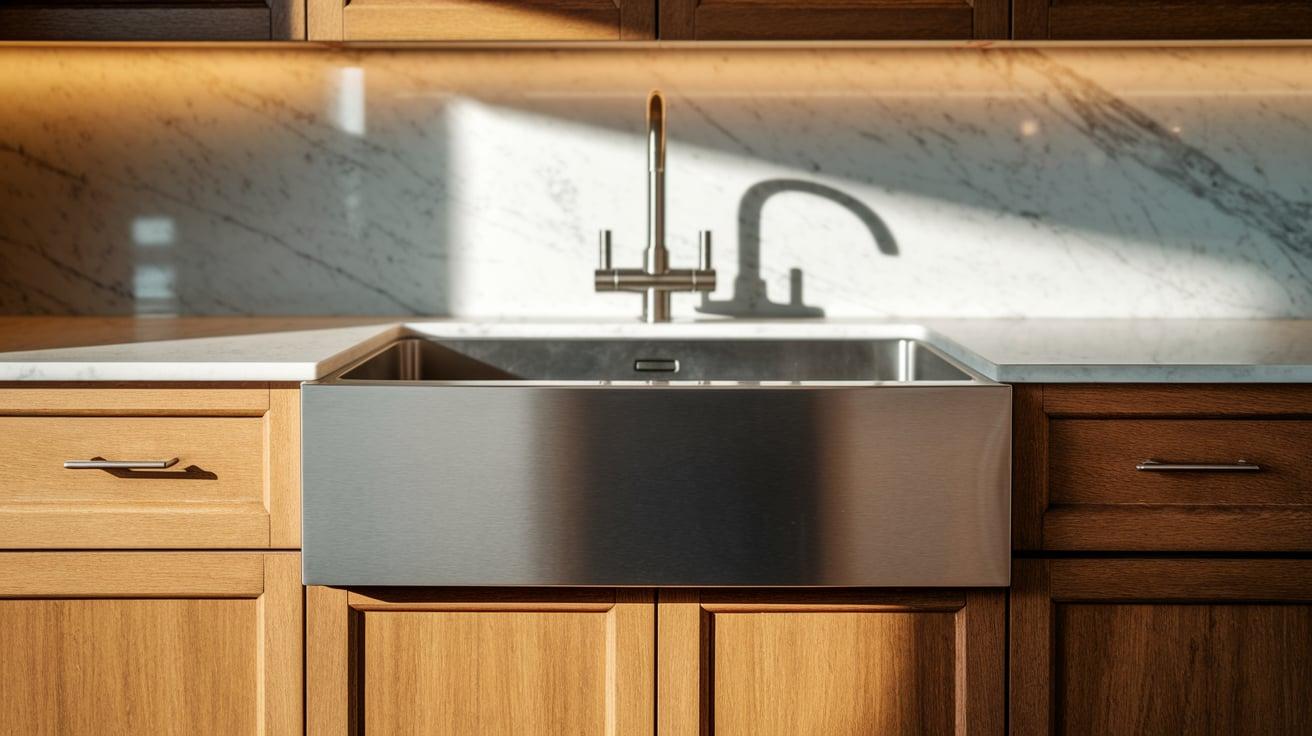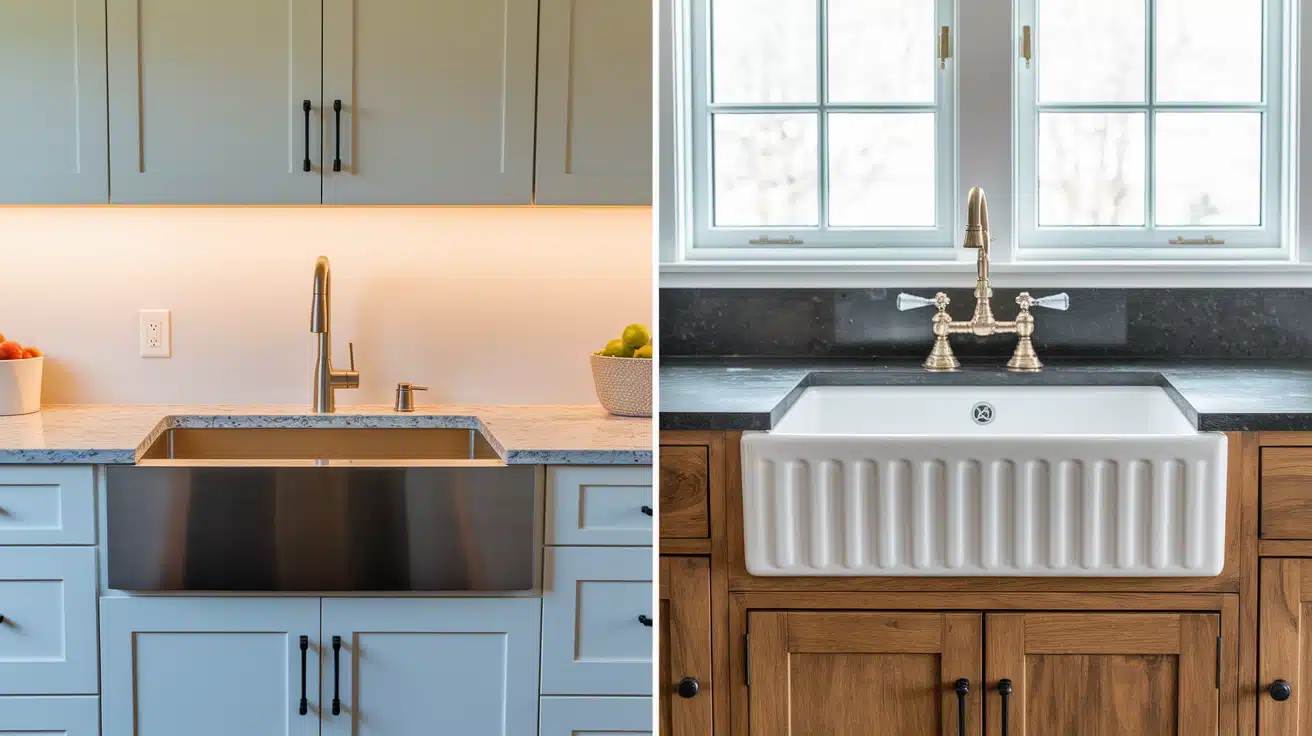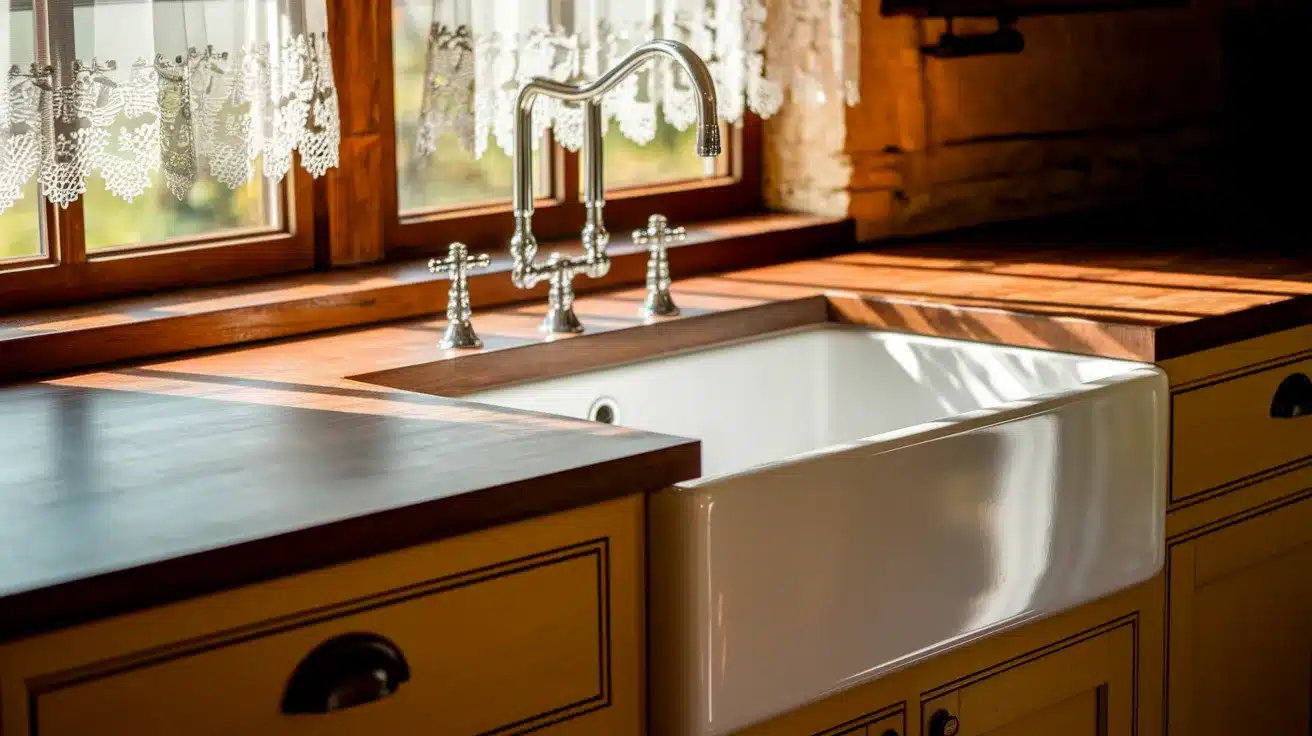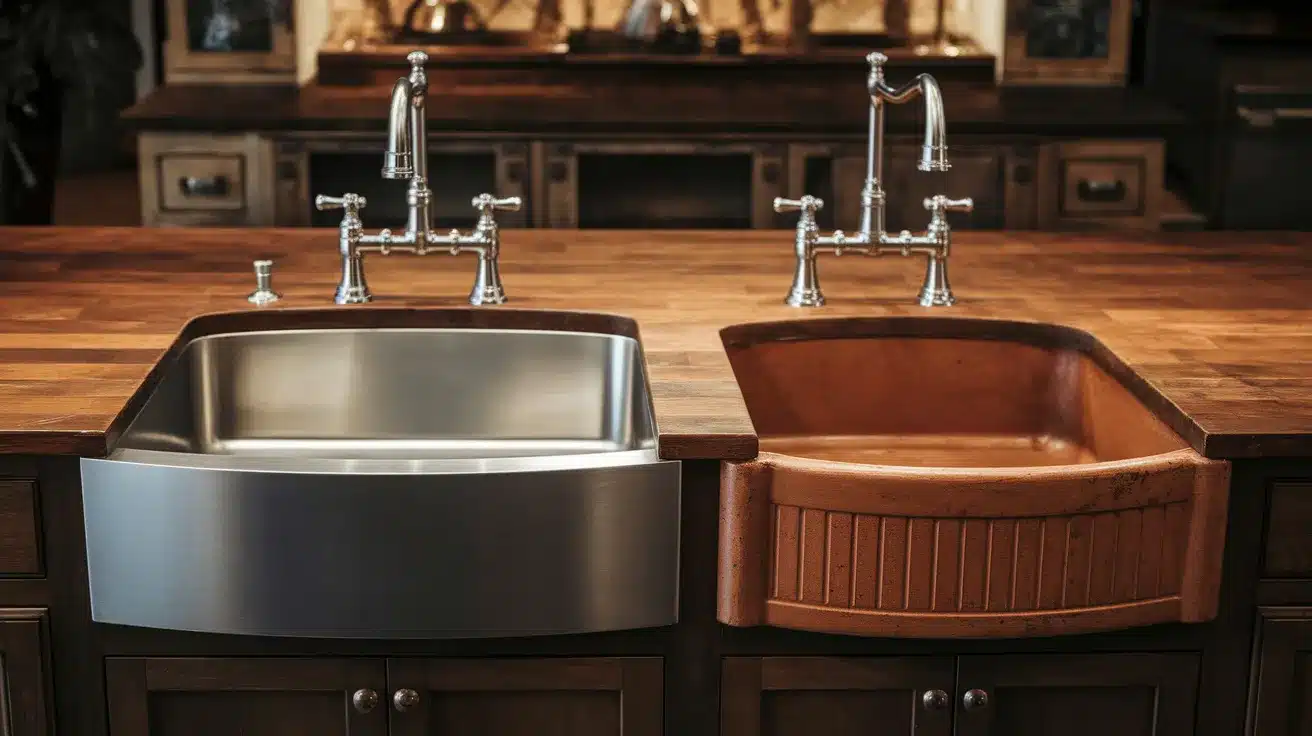Kitchen sinks have evolved from merely functional fixtures to design statements that define your space.
Two popular styles dominate today’s kitchen trends: apron sinks and farmhouse sinks. Many homeowners use these terms without knowing the fundamental differences between them.
While both feature that bold, exposed front panel, each brings unique benefits to your kitchen. Apron sinks offer a sleek, modern appeal that is perfect for contemporary homes.
Farmhouse sinks provide traditional charm with deep basins built for heavy-duty use. Choosing between an apron sink vs a farmhouse sink affects your kitchen’s look, functionality, and budget.
The right choice depends on your cooking habits, design preferences, and installation requirements. This guide breaks down everything you need to know to make the best decision for your home.
Apron vs Farmhouse Sinks: An Overview
Apron sinks and farmhouse sinks are two popular kitchen fixtures that many homeowners confuse. While these terms are used interchangeably, they have key differences worth knowing.
Both sink types feature a bold front panel that extends past your countertop. This exposed front creates a focal point in any kitchen.
Apron sinks lean toward modern, clean lines that fit today’s kitchen trends. Farmhouse sinks stick to traditional, country-style charm with deeper basins. You’ll find both styles made from similar materials. Fireclay, cast iron, and stainless steel top the list for both durability and aesthetic appeal.
The choice between them comes down to your kitchen’s style and how you use your space.
What is an Apron Sink?

An apron sink features a front-facing exposed panel that extends beyond your countertop edge. This design creates a bold focal point in your kitchen.
The exposed front panel gives the sink its name; it resembles an apron tied around the waist. Unlike standard under-mount sinks, apron sinks show off their front face as part of the design.
This style works well when you want your sink to stand out rather than blend in. The front panel can be flat, curved, or textured depending on your taste. Apron sinks fit perfectly in modern kitchens, where clean lines and statement pieces are most valued.
Material Options
Stainless steel offers a sleek, modern look that matches contemporary appliances. Porcelain provides a clean white finish that’s easy to maintain and timeless.
Fireclay provides a classic ceramic appearance with superior durability. Cast iron with enamel coating comes in various colors to match your kitchen theme.
Apron Sink Pros and Cons
| Pros | Cons |
|---|---|
| Modern aesthetic. | May require custom cabinetry. |
| Functional for high-traffic kitchens. | It can be challenging to maintain certain materials. |
| Easy to clean, especially for front-facing models. | Can be noisy when washing dishes (if stainless steel). |
| Available in various materials (porcelain, fireclay, etc.). | It may not be suitable for small kitchens. |
What is a Farmhouse Sink?
A farmhouse sink brings old-world charm straight from 19th-century farm kitchens into your modern home. These sinks originated when farmers required large, deep basins to handle extensive washing tasks.
The deep basin design can easily accommodate oversized pots and pans. The large, open front panel sits flush with your cabinets, creating that signature look. This exposed front makes washing dishes more comfortable since you don’t lean over a counter edge.
Farmhouse sinks work best in rustic or country-style kitchens. But their timeless appeal fits modern spaces too, when you want that classic touch.
Material Options
Fireclay offers the most traditional white finish that won’t chip or stain easily. Stainless steel versions provide easy cleaning and match modern appliances.
Copper develops a natural patina over time for a unique character. Cast iron with enamel coating gives you color options while staying durable for daily use.
Farmhouse Sink Pros and Cons
| Pros | Cons |
|---|---|
| Timeless, versatile design. | Potentially higher installation costs. |
| Spacious and practical for large kitchen tasks. | Takes up more space in smaller kitchens. |
| Ideal for heavy-duty use, like washing large pots. | Requires deep countertop cuts for installation. |
| Fits both traditional and modern designs. | Heavier than other sinks, potentially requiring stronger cabinetry. |
Apron Sink vs Farmhouse Sink: Which to Choose
Learn the key differences between apron and farmhouse sinks to help you choose the perfect style for your kitchen.
1. Design and Visuals
Apron Sink: Features modern, sleek lines that create a bold statement in contemporary kitchens. The clean geometry and minimalist approach fit today’s design trends. These sinks often have straight edges and flat fronts that complement modern appliances.
The exposed panel can be smooth or have subtle texturing. Apron sinks work well in open-concept homes where the kitchen flows into living spaces. They create visual interest without overwhelming the room’s design.
Farmhouse Sink: Offers traditional, rustic charm with a deeper basin that recalls old-country kitchen styles. The classic look brings warmth and character to any space.
These sinks typically feature curved or rounded edges that soften the kitchen’s appearance. The deep basin design was originally meant for practical farm work. Today’s farmhouse sinks keep that heritage while fitting modern needs. They create a cozy, lived-in feeling that many homeowners love.
2. Material Variety
Apron Sink: Most commonly made from stainless steel and porcelain for that modern appeal. These materials keep the clean, contemporary look intact. Stainless steel versions resist stains and scratches while matching modern appliances.
Porcelain options offer a crisp white finish that stays bright over time. Some apron sinks also come in composite materials that mimic natural stone. The material choice often depends on your kitchen’s color scheme and style goals.
Farmhouse Sink: Traditionally crafted from fireclay and cast iron, though modern versions include copper and stainless steel options. The material choice often reflects the classic heritage. Fireclay provides that authentic white ceramic look that’s been popular for centuries.
Cast iron with enamel coating offers durability with color options. Copper farmhouse sinks develop a natural patina that adds character over time.
3. Installation and Space Considerations
Apron Sink: Often requires specific cabinet adjustments or custom cabinetry to fit properly. The installation process can be more complex and costly. Your cabinets need to be cut to accommodate the exposed front panel.
This might mean hiring a professional carpenter before the plumber arrives. The sink’s weight also requires proper support underneath. Some apron sinks need special mounting hardware that adds to installation time and cost.
Farmhouse Sink: Usually easier to install, but requires a special under-mount design that supports the heavy weight and deep basin structure. The cabinet opening needs precise measurements to fit the large basin.
Most farmhouse sinks sit on a support structure inside the cabinet base. This design distributes the weight evenly across the cabinet frame. While the installation is straightforward, the sink’s size means you might lose some storage space underneath.
4. Functionality
Apron Sink: Comes in both shallow and deep basin options. The design focuses more on style than heavy-duty kitchen tasks. Shallow basins work well for light prep work and everyday dishwashing.
The open front design makes it comfortable to stand close while working. However, the style-focused design might not handle large pots as well as deeper options. The exposed front can also mean that water splashes more easily onto the floor.
Farmhouse Sink: Better suited for heavy-duty tasks like washing large pots and dishes. The deep basin handles big kitchen jobs with ease. These sinks can accommodate oversized items like roasting pans and stock pots.
The large capacity means less splashing when washing dishes. The deep design also provides more workspace for food prep tasks. Many farmhouse sinks include built-in drainboards or accessories that add functionality.
5. Maintenance
Apron Sink: Easier to clean due to the open front design. You can wipe down the exposed panel without reaching over counters. The smooth surfaces on most modern apron sinks resist stains and scratches.
Stainless steel versions need regular wiping to prevent water spots. Porcelain surfaces can be cleaned with standard household cleaners. The exposed front means any splashes or stains are visible and need prompt attention.
Farmhouse Sink: Similar cleaning process, but needs more care for specific materials like fireclay that can show water spots or require special cleaners. The deep basin can be harder to reach for thorough cleaning.
Fireclay surfaces need gentle cleaners to avoid damage to the finish. Cast iron sinks with enamel coating can chip if hit with heavy pots. Copper farmhouse sinks need special care to maintain their finish. The large size means more surface area to clean and maintain.
Cost Comparison: Apron Sink vs. Farmhouse Sink
| Feature | Apron Sink | Farmhouse Sink |
|---|---|---|
| Initial Cost | $300 – $2,000 (depends on material) | $300 – $2,000 (depends on material) |
| Installation Cost | $500 – $1,000 for custom cabinetry | $800 – $1,500 (due to custom fitting and heavy sink) |
| Maintenance Cost | Generally low, but can require regular cleaning (especially stainless steel) | Higher for certain materials (e.g., fireclay, copper) due to the care needed |
| Long-Term Durability | Stainless steel and porcelain last well | Fireclay and cast iron are more durable but cost more initially |
Which One is Better for Your Kitchen?
The right sink choice depends on your kitchen’s style, your cooking habits, and your budget.
For style considerations, apron sinks are best suited for modern, contemporary, or minimalist kitchens, where clean lines are most important. Farmhouse sinks fit perfectly in rustic, country, or traditional spaces but also add character to modern kitchens.
For functionality, large families and avid cooks benefit more from farmhouse sinks’ deep basins that handle big pots and heavy-duty washing.
Single people or light cooks might prefer the apron sink’s sleek design and easier maintenance. Stainless steel options cost less upfront, while fireclay and cast iron require a higher investment but last longer.
Installation costs vary, too. Apron sinks often require custom cabinet work, which adds $500-1,000 to your project. Consider your long-term needs since both sink types can last 15-20 years with proper care.
Frequently Asked Questions
What Is the Drawback of a Farmhouse Sink?
Higher installation costs, reduced under-sink storage, and potential back strain from deep basins.
Are Farmhouse Sinks Undermount or Drop-in?
Farmhouse sinks are typically undermount with exposed front panels.
Do Farmhouse Sinks Need a Special Drain?
Yes, they require special drain assemblies for deeper basins.
Is It Better to Use Undermount or Drop-in Sinks?
Undermount offers easier cleaning; drop-in costs less to install.










